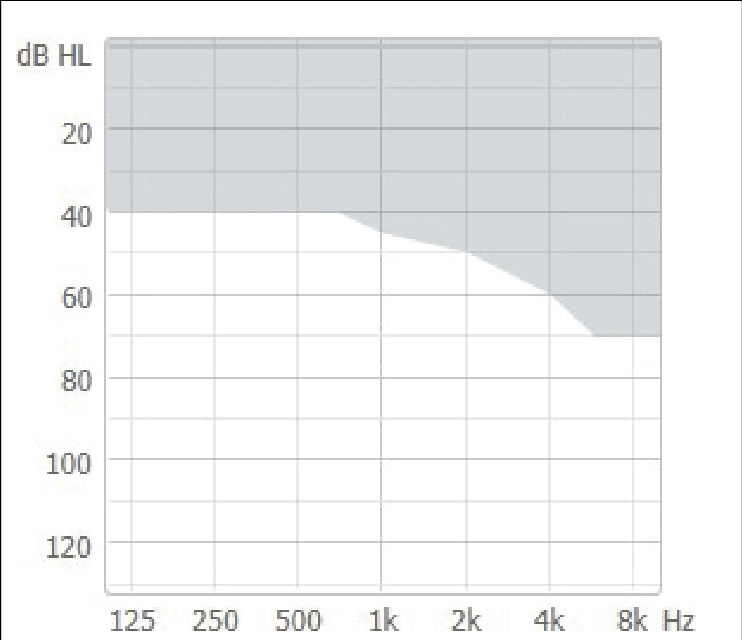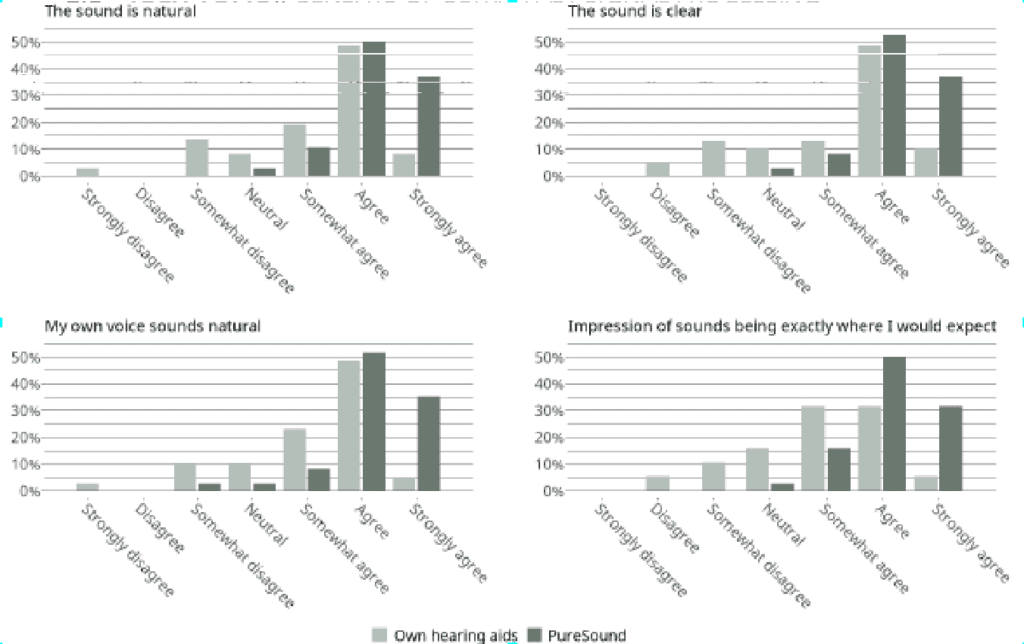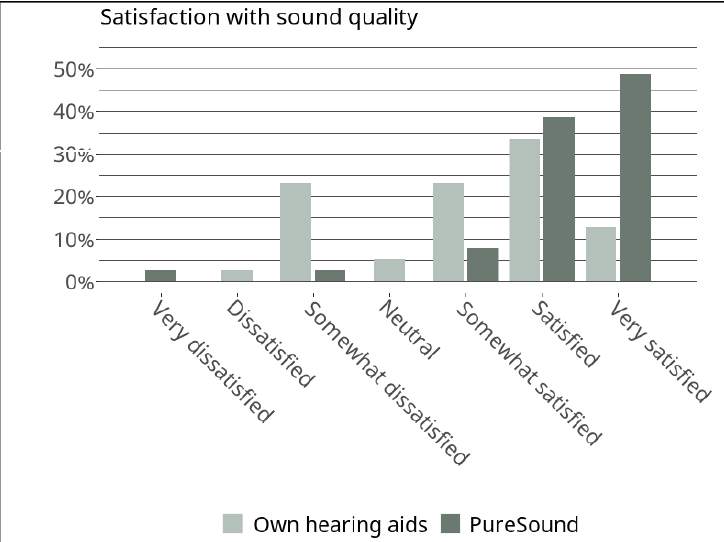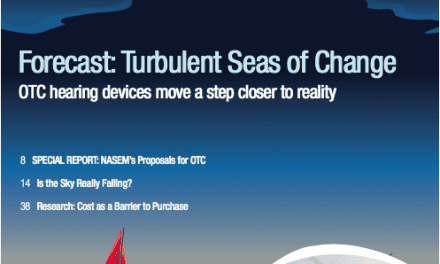Tech Topic | September 2021 Hearing Review
By Laura Winther Balling, PhD, Oliver Townend, BSc, and Dana Helmink, AuD
The ultra-fast signal processing found in Widex MOMENT PureSound hearing aids is designed to overcome long-standing barriers to great sound quality, and speech understanding and EEG data also suggest that users benefit from eliminating delay-based distortion. Exploring the effects of delay in real life, a survey of PureSound users showed that ultra-low delay is associated with higher ratings on a range of important parameters, including naturalness, localization, and hearing in noise.
Hearing aid development is often focused on numbers: the number of calculations performed in the hearing aid, the number of sound recordings processed, the size of the chip, or the delay of the amplified sound. While these aspects are important, they are not important in themselves; what really matters is how the numbers affect the experience of hearing aid users in their daily lives.
In the case of hearing aid delay, this has recently been the focus of Widex MOMENT hearing aids, which allow ultra-fast processing of the amplified signal with a delay of only 0.5 milliseconds (ms) via a dedicated automatic program called PureSound. This matters because a longer delay—even in the 4 to 8 ms range seen in other premium hearing aids—means that the amplified signal is out of phase with the direct sound that comes through and around the ear tip.1 For open and vented fits, this results in a distortion known as the comb-filter effect, which has negative consequences for sound quality 2 and neural representation of speech.3 The effects of this ultra-fast processing have been documented in a range of studies,1-4 but the ultimate test is how the sound is perceived by users in real life.
This article describes the results of a survey where a group of hearing aid users tried the PureSound program in real life and rated it in comparison to their existing hearing aids. The survey shows a range of advantages for the PureSound program that can be directly linked to processing delay, as well as derived advantages that are more indirect consequences of the ultra-fast processing.
Study Method
A total of 39 participants with hearing loss in the recommended range for the Widex PureSound program (Figure 1) took part in the survey. These mild-to-moderate hearing losses are where the comb-filter distortion is both most pronounced, because fittings tend to be open or vented, and most audible, because of the relatively good residual hearing. The participants were experienced hearing aid users, with ages between 20 to 88 (mean: 66 years), with 17 females and 22 males. The 39 participants were part of larger survey of Widex MOMENT (see Balling et al5). They were fitted with PureSound and asked a range of questions that relate particularly to the effects of delay.

Figure 1. Recommended fitting range for Widex PureSound program with ZeroDelay processing.
The survey used a cross-over design where participants initially (Week 0) rated their satisfaction with their own hearing aids (from all major brands), before being fitted with the Widex MOMENT hearing aids with PureSound. They then wore PureSound for 3 weeks and rated their satisfaction with it at Week 3. After this, they changed back to their own hearing aids, wore those for two weeks, and rated satisfaction with their own hearing aids again at Week 5. Finally, participants wore PureSound for 2 weeks and rated satisfaction with it again at Week 7.
All four sets of parallel questions are interesting to explore, but in this article the focus is on answers from Weeks 5 and 7, when participants were most used to the PureSound program and had the best basis for comparison.
Real-life Consequences of Delay
A subset of the survey questions was concerned with aspects that can be directly linked to delay, such as naturalness, clarity, own voice, and localization of sound. Participants were asked to indicate their level of agreement with the statements shown above the panels in Figure 2.

Figure 2. Ratings of agreement on the delay-related parameters general naturalness, clarity, naturalness of own voice, and localization of sounds.
The top-left panel shows the degree to which participants agreed that sound was natural, which was overwhelmingly the case for PureSound, with 95% of participants agreeing to a greater or lesser extent that the sound was natural. This is related to delay, in that a low-delay sound with no comb-filtering is less distorted and more natural than the delayed sound that is characteristic of other digital hearing aids, including the ones that the participants were already wearing. Most notable is the number of participants who “Strongly agree” that PureSound is natural, demonstrating the effectiveness of this approach to signal processing.
Clarity of sound is similarly related to delay, with the ultra-low delay of PureSound resulting in a clearer less-distorted sound. This relationship is apparent from the high clarity ratings shown in the top right panel of Figure 2 in which 95% of participants agreed that the sound of PureSound is clear. Again the results show a much higher proportion of “Strongly agree” for PureSound than for own hearing aids.
Another area where the effects of delay on naturalness are likely to be particularly pronounced is the experience of one’s own voice, where comb-filtering is especially audible and likely to reduce naturalness. This is indeed what we see in the bottom-left panel of Figure 2, where the naturalness ratings for own voice are higher for PureSound than for own hearing aids. This advantage for PureSound is particularly striking in view of the fact that the participants were experienced hearing aid users who have habituated to the sound of their own voice in their own hearing aids.
Finally, another variable that may be affected by the absence of comb-filtering is the ability to localize sounds. Participants’ agreement with the statement, “I have the impression of sounds being exactly where I would expect them to be,” is plotted in the bottom right panel of Figure 2, and this again shows markedly different distributions of answers for own hearing aids and PureSound, with high ratings for PureSound and medium ratings for own hearing aids.
What stands out across all four delay-related parameters shown in Figure 2 is the consistently high ratings for PureSound compared to participants’ own hearing aids—there are overall more who agree with the positive statements for PureSound, and especially more who “Strongly agree.” Interestingly, this PureSound advantage is seen in spite of the fact that participants were more used to the sound of their own hearing aids, and therefore could be expected to find both the sound in general and their own voice more natural, and to find it easier to localize sounds. This suggests that, even for experienced hearing aid wearers like those participating in this survey, delay does in fact affect the experienced quality of the sound.
Hearing in Noise
In addition to the specific delay-related parameters discussed in the previous section, the survey also included more general questions about the hearing aid experience. Among these, a prominent parameter for hearing aid users is satisfaction with hearing in noise, which is crucial to overall hearing aid satisfaction. For PureSound, satisfaction with hearing in noise is of particular interest, because the approach to noise is somewhat different in this program than in other hearing aids for two reasons. First, the processing philosophy behind PureSound is to make the entire soundscape available to the listener in order for the experience to be as natural as possible for those with mild-to-moderate hearing loss. Second, in order to keep delay ultralow, PureSound operates in omni mode rather than with directionality, which may affect the hearing experience in noisy situations.
These choices are validated by the results shown in Figure 3, which reflect very high satisfaction with PureSound in noisy backgrounds. The figure shows different distributions for PureSound and own hearing aids, with the most frequent rating being “Satisfied” for PureSound and “Somewhat satisfied” for own, with a marked difference in the proportion of “Very satisfied” participants. If we emulate MarkeTrak6 in grouping the three highest ratings together as “Satisfied,” we see that 82% of participants are satisfied with PureSound in noisy backgrounds, compared with 54% for own hearing aids. A likely explanation for this advantage is that the naturalness and the ability to localize sounds with PureSound make for better, more pleasant hearing experiences in noise and, consequently, increased satisfaction.

Figure 3. Ratings of satisfaction with hearing in noisy backgrounds.
Overall Sound Quality
A final general parameter to consider is the overall sound quality of the hearing aids. The Widex focus on naturalness of sound, which is particularly pronounced in the PureSound program, is based on a conviction that higher naturalness means higher perceived sound quality, which in turn is intended to make users more comfortable wearing their hearing aids in everyday life. Therefore, it is particularly interesting to see that the most frequent rating for the sound quality of PureSound is “Very satisfied,” and that almost all answers for PureSound are in the top three categories (Figure 4). This is in stark contrast to the number of participants dissatisfied to some extent with their own hearing aids.

Figure 4. Ratings of satisfaction with sound quality.
Discussion
As argued above, the real test of a new hearing aid or a new type of processing is in the real lives of hearing aid wearers. At the same time, it is reassuring that the results observed in the current field survey are in line with what has previously been observed in more controlled studies. The high naturalness and clarity ratings correspond closely to the qualitative observations made by participants in a previous guided-walk study.2 Naturalness and clarity are also likely contributors to the more robust neural representation observed for PureSound compared to other premium hearing aids.3 Finally, participants’ high satisfaction in noisy backgrounds helps explain why PureSound, which works without a directional microphone to keep delay ultra-low, shows speech intelligibility results on par with hearing aids that use directional microphones.4
In sum, PureSound shows substantial advantages, not only in the increased natural qualities of the sound it delivers, but also in other subjective benefits and preferences. Satisfaction in noise, localization of sounds, and naturalness of own voice are notable areas for hearing aid wearers to judge how a hearing aid sounds. In these areas, PureSound makes a marked improvement even to users who have already habituated to the sound of hearing aids. For new users, PureSound’s naturalness and similarity to unprocessed sound2 offers similar advantages. In this way, PureSound, with its ultra-low delay processing, answers some of the greatest challenges that hearing care providers face in addressing patient expectations. By addressing the needs of people with mild-to-moderate hearing losses, PureSound helps deliver on the Widex promise of great sound quality for all.

CORRESPONDENCE can be addressed to Dr Balling at: [email protected].
Citation for this article: Balling LW, Townend O, Helmink D. Sound quality for all: The benefits of ultra-fast signal processing in hearing aids. Hearing Review. 2021;28(9):32-35.
References
- Kuk F, Slugocki C. Quantifying acoustic distortions from hearing aid group delays. Widex Press. http://webfiles.widex.com/WebFiles/WidexPress-44.pdf. Published February 2021.
- Balling LW, Townend O, Stiefenhofer G, Switalski W. Reducing hearing aid delay for optimal sound quality: A new paradigm in processing. Hearing Review. 2020;27(4):20-26.
- Slugocki C, Kuk F, Korhonen P, Ruperto N. Neural encoding of the stimulus envelope facilitated by Widex ZeroDelay technology. Hearing Review. 2020;27(8):28-31.
- Kuk F, Ruperto N, Slugocki C, Korhonen P. Efficacy of directional microphones in open fittings under realistic signal-to-noise ratios using Widex Moment hearing aids. Hearing Review. 2020;27(6):20-23.
- Balling LW, Townend O, Helmink D. Sound quality in real life–Not just for experts. Hearing Review. 2021;28(2):27-30.
- Powers TA, Rogin CM. MarkeTrak 10: Hearing aids in an era of disruption and DTC/OTC devices. Hearing Review. 2019;26(8):12-20.




